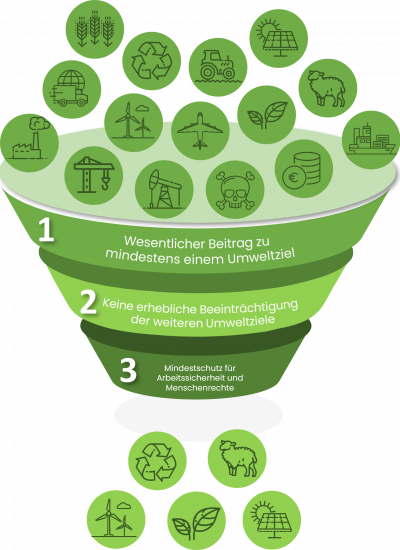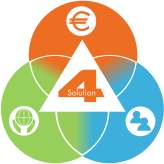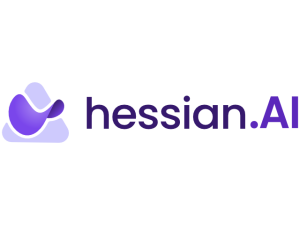What is the EU-TAXONOMY?

The EU Taxonomy is a classification system developed by the European Union to determine which economic activities can be classified as environmentally sustainable. The aim of the EU taxonomy is to provide investors, companies and political decision-makers with a uniform and transparent understanding of what constitutes a sustainable investment. This is intended to promote the flow of capital into sustainable projects and activities and support the implementation of the EU’s climate targets. The EU Taxonomy is a key part of the EU’s strategy to promote sustainable finance and achieve the climate goals of the Paris Agreement.
The ENVIRONMENTAL OBJECTIVES of the EU taxonomy
Companies and financial market participants must disclose what proportion of their activities and investments they classify as taxonomy-compliant. This includes quantitative and qualitative reports to ensure transparency and comparability. You must disclose which of the following 6 environmental objectives are affected by your activities.
Main criteria of the EU TAXONOMY
The EU taxonomy sets out clear criteria to determine which economic activities are considered environmentally sustainable. These criteria are designed to ensure that an activity makes a significant contribution to at least one of the six defined environmental objectives, does not cause significant harm to the other environmental objectives and complies with certain minimum safeguards. The six environmental objectives and the corresponding criteria are as follows:
Substantial contribution
The activity must demonstrably make a significant contribution to one or more of the six environmental objectives. This is defined by specific technical criteria that are defined for each activity.
Do No Significant Harm (DNSH)
The activity must not cause significant harm to any of the other environmental objectives. This requires a comprehensive assessment and compliance with the DNSH criteria for each environmental objective.
Minimum protection
The activity must comply with basic social and governance standards. These include compliance with labor rights, human rights and ethical business practices.
Who is OBLIGED?
In their non-financial reports (sustainability reports), these companies must provide information on the extent to which their economic activities meet the criteria of the EU taxonomy. The Non-Financial Reporting Directive (NFRD) has been extended by the Corporate Sustainability Reporting Directive (CSRD), meaning that more companies are affected by the reporting obligation.
Large companies with more than 500 employees
– Companies, that are subject to the Non-Financial Reporting Directive (NFRD)
– Companies listed on a regulated market within the EU
– Companies that exceed certain thresholds in terms of turnover and balance sheet total
Companies with more than 250 employees
– Uompanies that are subject to the Corporate Sustainability Reporting Directive (CSRD) are companies that meet at least two of the following three criteria:
– more than 250 employees
– more than 50 million euros in turnover
– more than 25 million euros in total assets
– all listed companies, with the exception of micro-enterprises
Smaller suppliers to industry
– Smaller companies SMEs are indirectly affected as suppliers to industry
– Industry must also request certain data (Product Carbon Footprint PCF) from suppliers
– Suppliers who cannot disclose to industry will be delisted in future
Large companies and financial market participants are mainly obliged to comply with the EU Taxonomy. The obligation includes the disclosure of how sustainable their economic activities and financial products are, based on the criteria of the EU Taxonomy. This serves to create transparency and promote the transition to a more sustainable economy.

The biggest PROBLEMS of the EU TAXONOMY
The implementation of the EU taxonomy poses various challenges for companies. These difficulties concern the organizational as well as the technical and content-related aspects of implementation. Here are some of the main challenges:
SOLUTION of the EU-TAXONOMY in SOLUTION4
The implementation of the EU taxonomy is a complex task that requires companies to make extensive adjustments and significant investments in data management, reporting and internal processes. Despite the challenges, the taxonomy also offers opportunities by helping companies to become more sustainable and remain more competitive in the long term.
The taxonomy reporting process with AEP Solution4 starts with the identification of your company’s economic activities using NACE codes that are already stored in the system. AEP Solution4 uses internal AI algorithms to automatically assign products and services to an appropriate NACE code. The assignment takes place automatically when the data is imported from the ERP article master. The NACE codes are then assigned to economic activities and environmental objectives. These links are already integrated in Solution4 and make it easier to assess the taxonomy conformity of products and services.
Solution4 analyses your products and their sales to determine the proportion of taxonomy-compliant sales.
Sustainability management tasks are visualized and processed in the “Green Controlling” module. The taxonomy report “Sales” and the taxonomy report “Capex” (for investments) can be generated and exported directly from the system.
Watch the video to find out about the possibilities offered by the taxonomy module. We will guide you through all components of the module and show you the steps for creating a taxonomy report that meets all requirements.

















